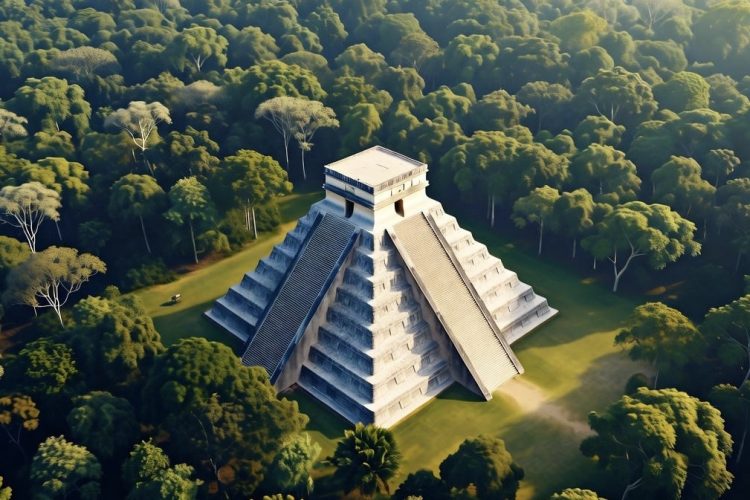Explore Mexico’s top 7 Maya ruins for history lovers. Chichen Itza features El Castillo pyramid with 365 steps, Great Ball Court, and Sacred Cenote from the classic period. Tulum, a coastal fortress on the Caribbean Sea, has the Temple of the Frescoes and acropolis pyramid. Coba offers Nohoch Mul, the tallest pyramid at 42m, plus sacbe roads and jungle paths. Palenque in Chiapas boasts the Temple of the Inscriptions with Pakal’s tomb and stucco sculptures. Calakmul, hidden in a biosphere reserve, has massive pyramids and over 6,500 structures. Ek Balam showcases the Acropolis with jaguar mouth entrance and detailed stucco. Uxmal on the Puuc route highlights the Pyramid of the Magician and Chaac mosaics. These UNESCO sites reveal Maya astronomy, rituals, and architecture—perfect for guided tours on your Yucatan Peninsula trip.
Long Version
7 Must-See Maya Ruins in Mexico for History Lovers
The ancient Maya civilization, a dazzling pillar of Mesoamerican history, thrived across Mexico’s lush Yucatan Peninsula and deeper into verdant jungles, etching an enduring legacy through towering pyramids, ornate temples, and sprawling archaeological sites that still whisper secrets of a brilliant society. These pre-Columbian marvels, often shrouded in thick jungle canopies or perched along the Riviera Maya shores gazing out at the crystalline Caribbean Sea, deliver profound glimpses into a world of astronomical genius, architectural mastery, and profound ritual practices. As bucket-list essentials for history lovers, these must-see spots invite immersive guided tours or solitary wanders during a transformative Mexico vacation, unveiling tales from the classic period laced with echoes of human sacrifices and ritual sacrifice that shaped this enigmatic civilization.
1. Chichen Itza: Icon of the New Seven Wonders
Chichen Itza emerges as a colossal testament to Maya ingenuity in the northern lowlands, dominating the landscape from the late classic period around AD 600–900 into the terminal classic era. This vast expanse, covering about 5 square kilometers amid sun-dappled clearings, centers on the majestic El Castillo, known as the Temple of Kukulcan—a 30-meter pyramid with steep stairways of 91 steps each, culminating in a top platform that totals 365 to mirror the solar calendar’s rhythm. Crafted between the 9th and 12th centuries, its design harnesses shadows during equinoxes to conjure a slithering serpent descending the balustrades, a breathtaking display of astronomical prowess. Nearby, the Great Ball Court stretches as the largest in Mesoamerica, its high stone walls echoing ancient games that culminated in ritual sacrifice; the Temple of the Warriors rises with rows of carved columns depicting fierce guardians; the Skull Platform grimly displays rows of sculpted crania; and the Sacred Cenote plunges as a shadowy sinkhole once brimming with ceremonial offerings. Wandering these grounds evokes the pulse of a thriving city, where echoes of crowds and chants linger in the warm air, though modern preservation rules bar climbing to safeguard the stones.
2. Tulum: Coastal Fortress Overlooking the Sea
Tulum clings dramatically to rugged limestone cliffs, the sole major Maya stronghold hugging the Caribbean Sea’s azure expanse, functioning as a bustling port in the post-classic period from AD 1200–1521. This Riviera Maya jewel, bathed in salty breezes and framed by swaying palms, boasts fortified walls encircling compact yet elegant structures, including the Temple of the Frescoes adorned with vibrant painted murals that capture divine figures and celestial narratives in faded hues of red and blue. Its acropolis pyramid commands sweeping vistas over powdery beaches and crashing waves, fusing raw natural splendor with historical depth for an unforgettable vacation retreat. Distinct from inland jungle enclaves, Tulum’s seaside perch fueled vibrant trade routes, and its intimate scale allows swift traversal in under an hour, though guided tours unveil layers of ritual practices and the site’s pivotal role in Maya civilization. Pairing a visit with nearby cenotes like Cenote Ik Kil adds a refreshing plunge into cool, cavernous waters, enhancing the sensory allure of this coastal gem.
3. Coba: Network of Ancient Pathways
Coba sprawls as an immense archaeological site in Quintana Roo’s tangled undergrowth, rising to prominence from the early classic period around AD 250–600 and sustaining a population exceeding 50,000 across over 80 square kilometers, with thousands of structures veiled in foliage awaiting discovery. What sets it apart is the intricate web of sacbe—elevated white stone causeways snaking through the greenery, linking clusters of buildings like arteries in a living organism. Dominating the scene is the Nohoch Mul pyramid, soaring 42 meters as the Yucatan Peninsula’s tallest, its weathered steps inviting climbers to ascend for breathtaking panoramas where treetops stretch endlessly, punctuated by the guttural calls of howler monkeys swinging through branches. Additional treasures include the Great Ball Court, etched with remnants of intense competitions, and scattered stucco sculptures that hint at trade networks and sacred rites. Renting bicycles to glide along these ancient paths transforms exploration into an exhilarating adventure, immersing visitors in the humid, vibrant jungle that once cradled this powerful hub.
4. Palenque: Jewel of the Chiapas Jungle
Palenque nestles in the misty foothills of Chiapas, a late classic period powerhouse from AD 600–900 celebrated for its exquisite architecture and deciphered inscriptions that unravel Maya enigmas like threads from a forgotten tapestry. At its heart lies the Temple of the Inscriptions, concealing the elaborate tomb of ruler Pakal the Great, unearthed in 1952 with a sarcophagus lid intricately carved to portray cosmic journeys amid swirling motifs. Perched on a natural plateau enveloped in fog-kissed jungle, the site unfolds with painted walls glowing in subtle pigments, elaborate stucco sculptures of deities and rulers, and the sprawling Palace featuring an observation tower and innovative aqueduct channels that once funneled rainwater like veins of life. Within this biosphere reserve, the air hums with the roars of howler monkeys and the distant rumble of cascading waterfalls, creating an ethereal backdrop that amplifies the site’s engineering feats. Guided tours prove essential for decoding the hieroglyphic stories and ritual contexts, drawing you into the intimate dramas of a royal court lost to time.
5. Calakmul: Hidden Power in the Biosphere
Buried deep in the Calakmul Biosphere Reserve’s impenetrable wilderness, this ancient Maya metropolis matches rivals in grandeur, boasting over 6,500 structures across 70 square kilometers, many still cloaked in vines and unearthed secrets from pre-classic to late classic eras. As a once-dominant superpower, its pyramids pierce the canopy, with Structure II towering 45 meters in a symphony of stone steps that reward climbers with horizons of unbroken green, alive with the chatter of exotic birds and elusive wildlife. Scattered sacbe pathways and weathered stelae recount epic rivalries and solemn rituals, their carvings weathered yet vivid under dappled sunlight. This UNESCO-protected haven demands adventurous spirits for its remote trails, where the entrance weaves through dense foliage teeming with life, offering a serene escape from throngs and a profound connection to the Maya’s untamed world.
6. Ek Balam: Guardian of Stucco Masterpieces
Ek Balam unfolds in the Yucatan Peninsula’s heart, a site spanning from the middle pre-classic around 700 BCE to the terminal classic, anchored by its colossal Acropolis pyramid—over 30 meters high and 151 meters long—that guards the tomb of ruler Ukit Kan Lek Tok amid a gallery of masterful stucco sculptures. The entrance, framed by a fearsome jaguar mouth symbolizing the underworld’s maw, features fangs and eyes rendered in exquisite detail, as if frozen in a eternal roar. Less trodden than its famed counterparts, it permits ascents for commanding views over rolling landscapes, complemented by a ball court etched with echoes of ancient contests and encircling defensive walls that speak of strategic prowess. Vibrant painted murals and sculptures offer rare windows into Maya artistry, depicting gods and myths in bold strokes, making this under-the-radar treasure a captivating draw for those on guided tours seeking unfiltered immersion.
7. Uxmal: Pinnacle of Puuc Architecture
Uxmal gleams as a late classic Puuc route masterpiece from AD 700–1000, embodying refined elegance through intricate geometric mosaics, softly rounded corners, and prolific stucco sculptures honoring the rain god Chaac with protruding noses and curling motifs that dance across facades. The Pyramid of the Magician commands attention, layered in five phases to reach 35 meters with an elliptical base that defies convention, rising like a stepped sentinel against the sky. The Governor’s Palace sprawls nearby, its friezes a tapestry of serpents and lattices under golden sunsets. Linked by ancient roads to kindred sites along the 40-kilometer Puuc route, Uxmal harmonizes with its jungle surroundings, where evening hues cast long shadows over the stones. Guided tours illuminate ties to astronomy and agriculture, revealing how rituals wove into the fabric of daily life in this architectural symphony.
These seven Maya ruins distill the essence of ancient Maya brilliance, from seaside bastions to forest-shrouded citadels, crafting an epic odyssey through time. Approach your journey with reverence for their fragility, embracing sustainable guided tours to unearth deeper layers while preserving their timeless allure.

Hashtags For Social Media
#MayaRuins #ChichenItza #TulumMexico #CobaPyramid #PalenqueRuins #Calakmul #EkBalam #Uxmal #YucatanTravel #MexicoTravel #TravelMexico #AncientCivilizations #MayanCulture #MayanHistory #ArchaeologyLovers #UNESCOSites #HistoricalTravel #TravelDestinations #WanderlustMexico #TravelPhotography #AdventureTravel #BucketListDestinations #HiddenGemsMexico #MayaArchitecture #TravelInspiration #ExploreMexico #CultureTrip #AncientRuins #HistoryLovers #TravelAddict #CaribbeanMexico
Related Questions, Words, Phrases
what are the best maya ruins to visit in mexico | which maya ruins should i see on a yucatan trip | top maya archaeological sites in mexico | how many maya ruins are in mexico | what is there to see at chichen itza | best guided tours for maya ruins in mexico | tips for visiting tulum ruins | how tall is the nohoch mul pyramid in coba | what to know before visiting palenque | hidden maya ruins in mexico | can you climb pyramids at uxmal | ek balam highlights and attractions | best time of year to visit maya ruins | maya ruins with cenotes nearby | historical facts about calakmul | how to get to chichen itza from cancun | maya ruins near the caribbean coast | family-friendly maya ruins tours | most photogenic maya ruins in mexico | maya ruins with ancient temples | how long should i spend at palenque | famous maya pyramids to visit | which ruins are off the beaten path | maya ruins guided tour vs self-tour | exploring maya astronomy at chichen itza | what to pack for a maya ruins trip | ruins with the best jungle scenery | temples and pyramids in uxmal | ek balam architecture details | cobá sacbe roads and jungle paths | historical significance of tulum | travel tips for visiting calakmul | ancient maya ruins with inscriptions






